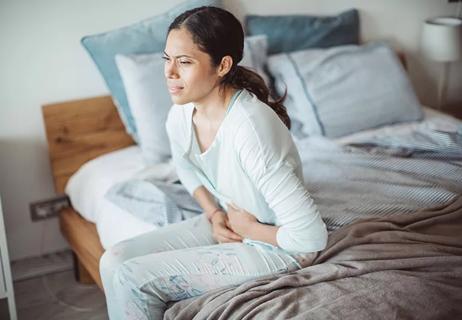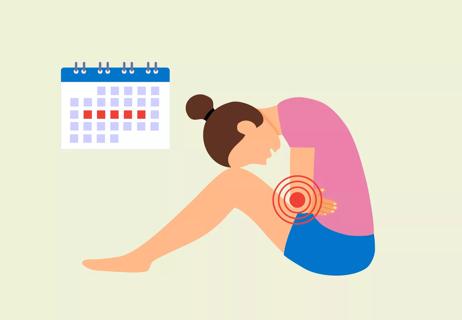Food is medicine when you’re dealing with endometriosis

Heavy periods, pain and nausea. The symptoms of endometriosis aren’t just distressing, they interfere with your day-to-day life.
Advertisement
Cleveland Clinic is a non-profit academic medical center. Advertising on our site helps support our mission. We do not endorse non-Cleveland Clinic products or services. Policy
When you have endometriosis, cells that are very similar to the cells from your endometrium (lining of your uterus) grow in other parts of your body. The cells may stick to your bladder, fallopian tubes or other organs. Then, the cells try to shed during your period — but the blood has nowhere to go.
The trapped blood from the misplaced cells causes inflammation of nearby organs and tissues. This inflammation can lead to endometriosis symptoms like pain, fatigue and digestive problems, as well as, in some cases, infertility.
But an endometriosis diet could be the key to relief from the agony. Registered dietitian Courtney Barth, RD, explains which foods could help fight endometriosis symptoms and which ones make them worse.
Inflammation and high estrogen levels can make endometriosis symptoms worse. And your diet can influence both factors.
“Food plays an important role in helping your body fight inflammation and balance estrogen,” says Barth. “Many people find that the right diet can significantly reduce endometriosis symptoms.”
Estrogen is a key hormone, and you need some of it for normal functioning. But too much estrogen can aggravate endometriosis symptoms like cramping and pain. That’s where food and fiber can come to the rescue.
Advertisement
“Your body gets rid of excess estrogen in the stool,” explains Barth. “You should have a healthy bowel movement every day. If you don’t, you probably have constipation, and your estrogen levels could be too high.”
Kick constipation — and extra estrogen — to the curb by filling up on fiber. “Adults should eat 35 grams of fiber every day,” says Barth.
You can boost your fiber by eating more:
Just be sure to increase your fiber intake gradually. “Adding a lot of fiber at once can cause bloating, gas and digestive discomfort,” says Barth. “Raise your fiber intake slowly and drink plenty of water to minimize these side effects. Ground flaxseed is packed with fiber, so don’t eat more than 3 tablespoons per day.”
Endometriosis is an inflammatory condition, so inflammation makes symptoms worse. Omega-3 fats can calm inflammation from endometriosis. Good food sources of omega-3s include:
Monounsaturated fats also have anti-inflammatory power. They’re found in:
Calcium gets a lot of attention as an important mineral. But if you have endometriosis, make sure you’re also getting magnesium and zinc.
“Magnesium helps with menstrual cramps,” says Barth. “It’s a natural muscle relaxer.” Magnesium-rich foods include:
Zinc regulates your menstrual cycles, which is important for hormonal balance. “Zinc helps your body ovulate, or release an egg,” explains Barth. “When you ovulate, you produce progesterone, which balances out estrogen. Ovulating is also necessary if you’re trying to get pregnant.”
The highest sources of zinc are animal sources. So if you eat a vegetarian or vegan diet, ask your doctor if you should take a zinc supplement. Good sources of zinc include:
Advertisement
Learn what foods to eat to help with endometriosis.
Certain foods can worsen endometriosis pain by boosting inflammation or estrogen levels. Limit or avoid:
Some people with endometriosis find that a gluten-free or dairy-free diet helps them feel better. But it depends on the person.
“If you’ve tried eating healthier and it’s not enough, then cutting out gluten or dairy is often the next step,” says Barth. “I usually recommend going gluten-free or dairy-free for at least a month. Then slowly add it back into your diet and see if your symptoms come back.”
Advertisement
You can also pinpoint problem foods with the low-FODMAP diet. “The low-FODMAP diet is designed for people with irritable bowel syndrome, but it can work with endometriosis, too,” says Barth. “If you follow it closely, you might find that certain foods trigger your endometriosis symptoms.”
It might be tempting to pop some pills instead of updating your diet. But don’t be quick to try supplements for endometriosis unless your doctor gives you the go-ahead.
“Your doctor can run tests to see if you’re deficient in certain nutrients,” says Barth. “Then, if your doctor recommends it, take supplements to fill any nutritional gaps. Supplements should be based on your health needs, not a one-size-fits-all approach.”
Looking for some endometriosis-friendly meals? Try these recipes:
Advertisement
Endometriosis can be debilitating, but one part of managing it could be as close as your kitchen. “If endometriosis is interfering with your life, try changing your diet,” says Barth. “It won’t hurt, and it could really help.”
Learn more about our editorial process.
Advertisement

The most comfortable sex positions minimize deep penetration

Endometriosis pain occurs where the disease develops in your body

Vaginal pain can be caused by infections, cysts or other conditions

5 things to know about the signs of endometriosis

Endometriosis, pelvic floor dysfunction and bladder issues can all contribute, but relief is within reach

Developmental changes like puberty and menopause can impact symptom severity

They can happen whether you’re having a period or not

From medications and stress to PCOS and STIs, there’s a wide range of reasons Aunt Flo may overstay her welcome

Type 2 diabetes isn’t inevitable with these dietary changes

Applying a hot or cold compress can help with pain